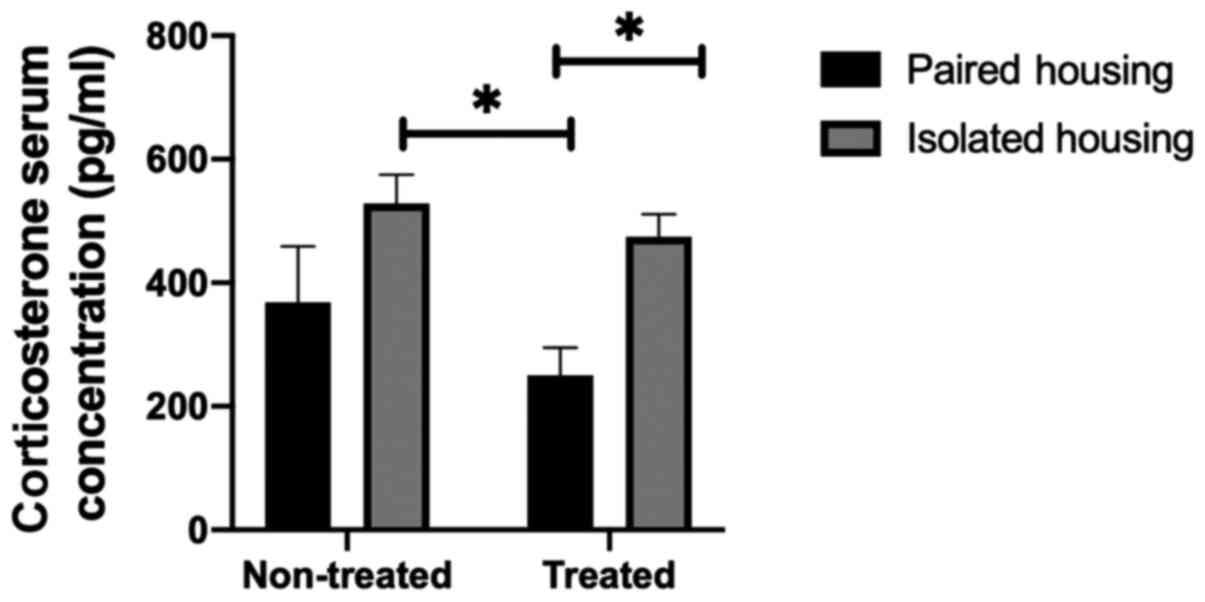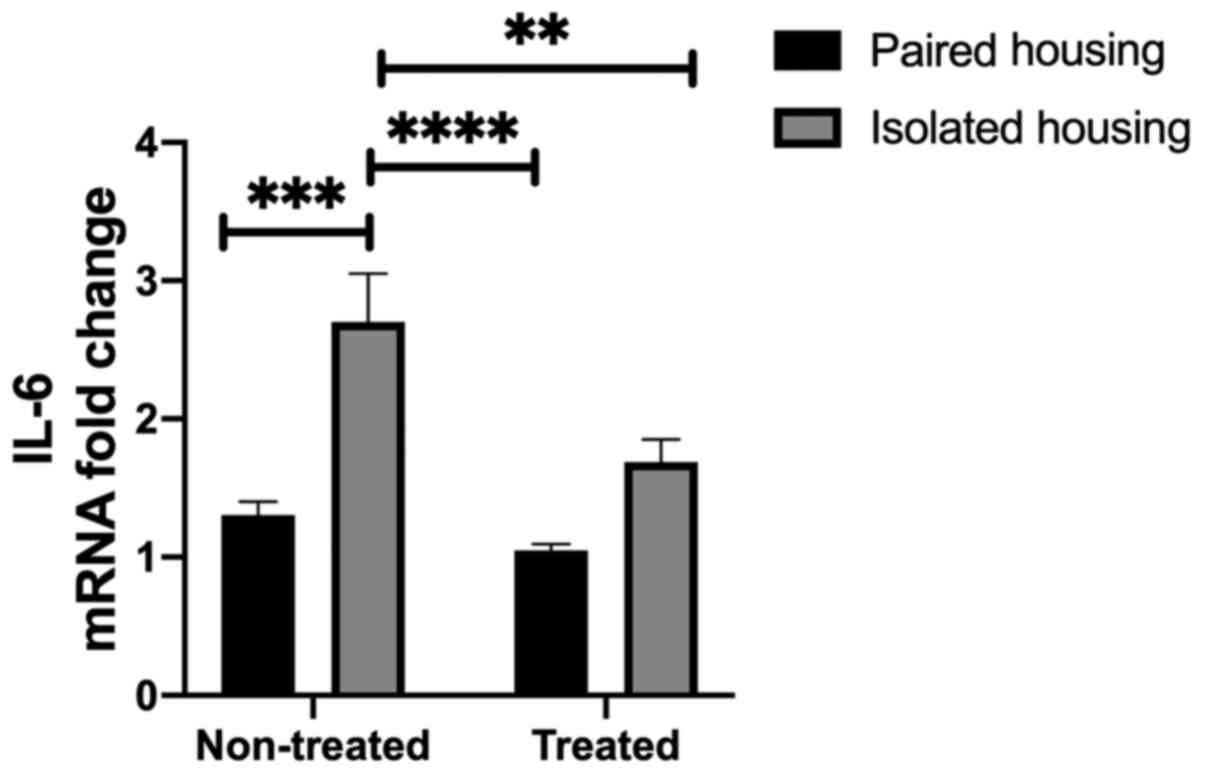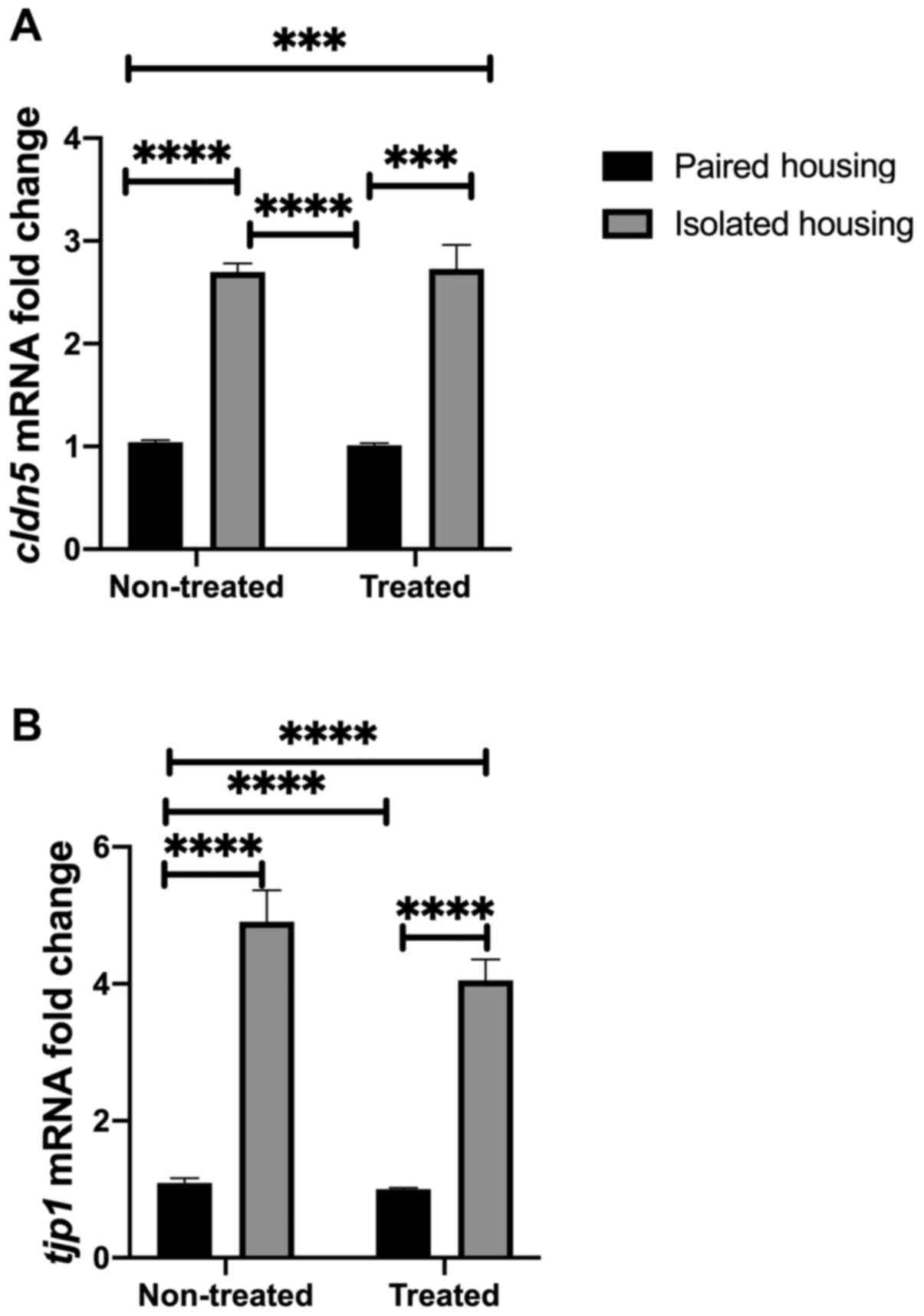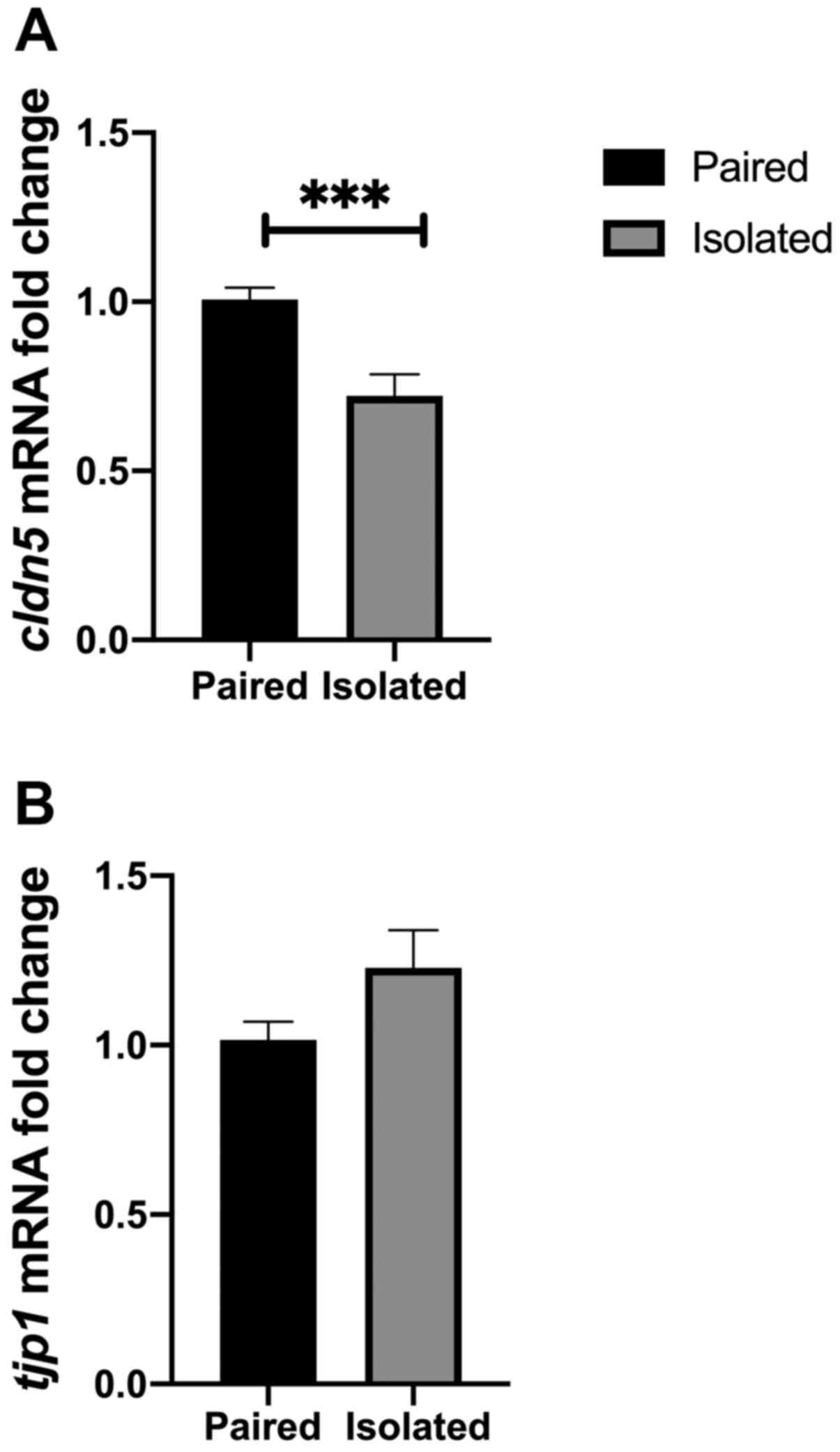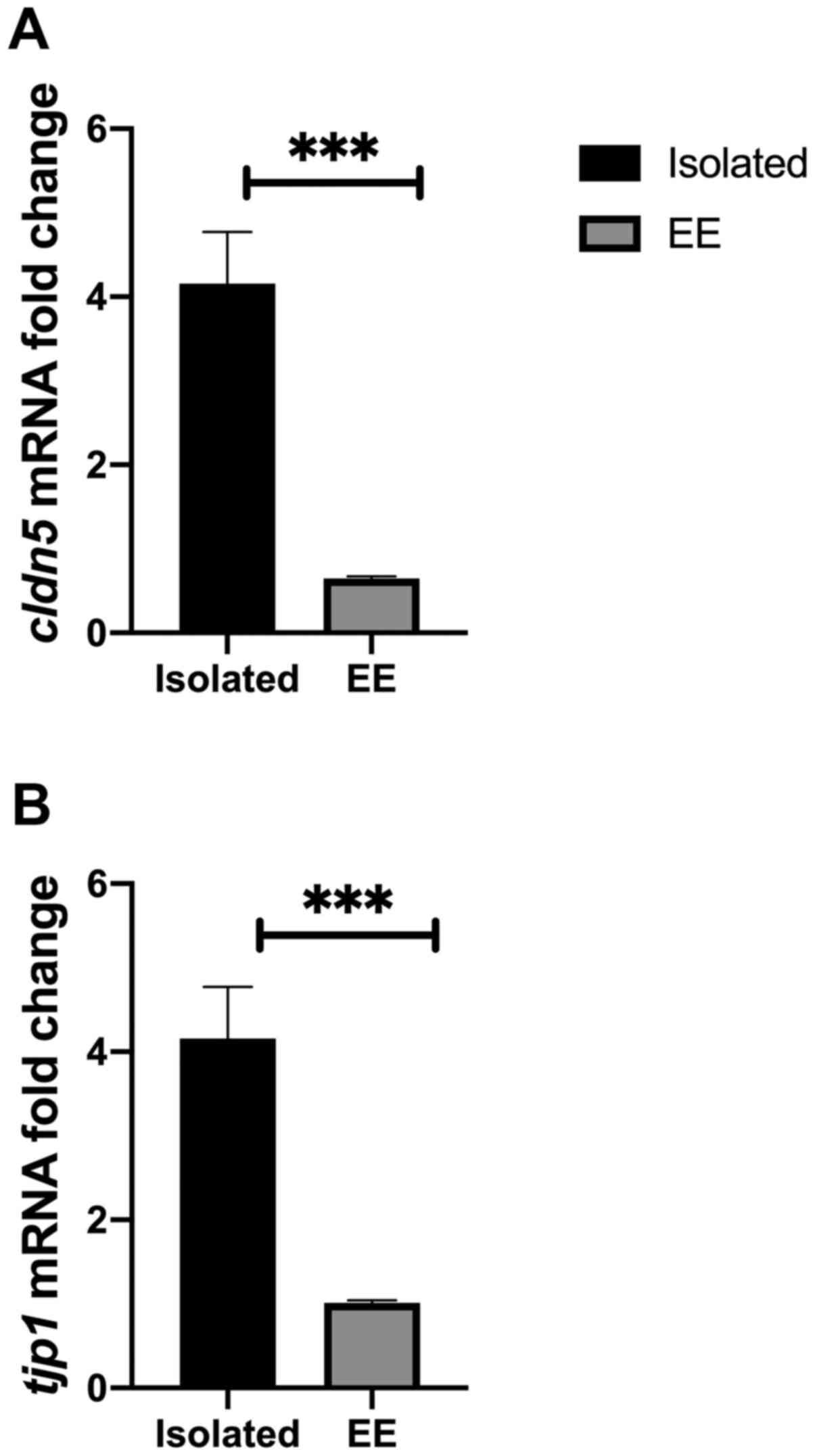|
1
|
Abelaira HM, Réus GZ and Quevedo J: Animal
models as tools to study the pathophysiology of depression. Braz J
Psychiatry. 35 (Suppl 2):S112–S120. 2013.PubMed/NCBI View Article : Google Scholar
|
|
2
|
Ilin Y and Richter-Levin G: Enriched
environment experience overcomes learning deficits and
depressive-like behavior induced by juvenile stress. PLoS One.
4(e4329)2009.PubMed/NCBI View Article : Google Scholar
|
|
3
|
Fernández-Guasti A, Fiedler JL, Herrera L
and Handa RJ: Sex, stress, and mood disorders: At the intersection
of adrenal and gonadal hormones. Horm Metab Res. 44:607–618.
2012.PubMed/NCBI View Article : Google Scholar
|
|
4
|
Calabrese F, Molteni R, Racagni G and Riva
MA: Neuronal plasticity: A link between stress and mood disorders.
Psychoneuroendocrinology. 34 (Suppl 1):S208–S216. 2009.PubMed/NCBI View Article : Google Scholar
|
|
5
|
Segerstrom SC and Miller GE: Psychological
stress and the human immune system: A meta-analytic study of 30
years of inquiry. Psychol Bull. 130:601–630. 2004.PubMed/NCBI View Article : Google Scholar
|
|
6
|
Lupien SJ, McEwen BS, Gunnar MR and Heim
C: Effects of stress throughout the lifespan on the brain,
behaviour and cognition. Nat Rev Neurosci. 10:434–445.
2009.PubMed/NCBI View
Article : Google Scholar
|
|
7
|
Cacioppo JT, Cacioppo S, Capitanio JP and
Cole SW: The neuroendocrinology of social isolation. Annu Rev
Psychol. 66:733–767. 2015.PubMed/NCBI View Article : Google Scholar
|
|
8
|
Coleman K, Weed JL and Schapiro SJ:
Environmental enrichment for animals used in research. In: Animal
Models for the Study of Human Disease. Conn PM (ed). Academic
Press, London, pp74-94, 2013.
|
|
9
|
Jia J and Le W: Molecular network of
neuronal autophagy in the pathophysiology and treatment of
depression. Neurosci Bull. 31:427–434. 2015.PubMed/NCBI View Article : Google Scholar
|
|
10
|
Mehta-Raghavan NS, Wert SL, Morley C, Graf
EN and Redei EE: Nature and nurture: Environmental influences on a
genetic rat model of depression. Transl Psychiatry.
6(e770)2016.PubMed/NCBI View Article : Google Scholar
|
|
11
|
Al-Qadhi W, Ur Rahman S, Ferwana MS and
Abdulmajeed IA: Adult depression screening in Saudi primary care:
Prevalence, instrument and cost. BMC Psychiatry.
14(190)2014.PubMed/NCBI View Article : Google Scholar
|
|
12
|
Jiao H, Wang Z, Liu Y, Wang P and Xue Y:
Specific role of tight junction proteins claudin-5, occludin, and
ZO-1 of the blood-brain barrier in a focal cerebral ischemic
insult. J Mol Neurosci. 44:130–139. 2011.PubMed/NCBI View Article : Google Scholar
|
|
13
|
Daneman R and Prat A: The blood-brain
barrier. Cold Spring Harb Perspect Biol. 7(a020412)2015.PubMed/NCBI View Article : Google Scholar
|
|
14
|
Menard C, Pfau ML, Hodes GE, Kana V, Wang
VX, Bouchard S, Takahashi A, Flanigan ME, Aleyasin H, LeClair KB,
et al: Social stress induces neurovascular pathology promoting
depression. Nat Neurosci. 20:1752–1760. 2017.PubMed/NCBI View Article : Google Scholar
|
|
15
|
Haapakoski R, Ebmeier KP, Alenius H and
Kivimäki M: Innate and adaptive immunity in the development of
depression: An update on current knowledge and technological
advances. Prog Neuropsychopharmacol Biol Psychiatry. 66:63–72.
2016.PubMed/NCBI View Article : Google Scholar
|
|
16
|
Miller AH and Raison CL: The role of
inflammation in depression: From evolutionary imperative to modern
treatment target. Nat Rev Immunol. 16:22–34. 2016.PubMed/NCBI View Article : Google Scholar
|
|
17
|
Alshammari TK, Alghamdi H, Green TA, Niazy
A, Alkahdar L, Alrasheed N, Alhosaini K, Alswayyed M, Elango R,
Laezza F, et al: Assessing the role of toll-like receptor in
isolated, standard and enriched housing conditions. PLoS One.
14(e0222818)2019.PubMed/NCBI View Article : Google Scholar
|
|
18
|
Liu YZ, Wang YX and Jiang CL:
Inflammation: The common pathway of stress-related diseases. Front
Hum Neurosci. 11(316)2017.PubMed/NCBI View Article : Google Scholar
|
|
19
|
Hodes GE, Ménard C and Russo SJ:
Integrating Interleukin-6 into depression diagnosis and treatment.
Neurobiol Stress. 4:15–22. 2016.PubMed/NCBI View Article : Google Scholar
|
|
20
|
Ting EY, Yang AC and Tsai SJ: Role of
interleukin-6 in depressive disorder. Int J Mol Sci.
21(2194)2020.PubMed/NCBI View Article : Google Scholar
|
|
21
|
Himmerich H, Patsalos O, Lichtblau N,
Ibrahim MAA and Dalton B: Cytokine research in depression:
principles, challenges, and open questions. Front Psychiatry.
10(30)2019.PubMed/NCBI View Article : Google Scholar
|
|
22
|
Moncek F, Duncko R, Johansson BB and
Jezova D: Effect of environmental enrichment on stress related
systems in rats. J Neuroendocrinol. 16:423–431. 2004.PubMed/NCBI View Article : Google Scholar
|
|
23
|
Castrén E and Hen R: Neuronal plasticity
and antidepressant actions. Trends Neurosci. 36:259–267.
2013.PubMed/NCBI View Article : Google Scholar
|
|
24
|
Alshammari TK, Alghamdi H, Alkhader LF,
Alqahtani Q, Alrasheed NM, Yacoub H, Alnaem N, AlNakiyah M and
Alshammari MA: Analysis of the molecular and behavioral effects of
acute social isolation on rats. Behav Brain Res.
377(112191)2020.PubMed/NCBI View Article : Google Scholar
|
|
25
|
Livak KJ and Schmittgen TD: Analysis of
relative gene expression data using real-time quantitative PCR and
the 2(-Delta Delta C(T)) method. Methods. 25:402–408.
2001.PubMed/NCBI View Article : Google Scholar
|
|
26
|
Bauer HC, Krizbai IA, Bauer H and Traweger
A: ‘You Shall Not Pass’-tight junctions of the blood brain barrier.
Front Neurosci. 8(392)2014.PubMed/NCBI View Article : Google Scholar
|
|
27
|
Holt-Lunstad J: The potential public
health relevance of social isolation and loneliness: Prevalence,
epidemiology, and risk factors. Public Policy Aging Rep.
27:127–130. 2017.
|
|
28
|
Dudek KA, Dion-Albert L, Lebel M, LeClair
K, Labrecque S, Tuck E, Ferrer Perez C, Golden SA, Tamminga C,
Turecki G, et al: Molecular adaptations of the blood-brain barrier
promote stress resilience vs depression. Proc Natl Acad Sci USA.
117:3326–3336. 2020.PubMed/NCBI View Article : Google Scholar
|
|
29
|
Sargin D, Oliver DK and Lambe EK: Chronic
social isolation reduces 5-HT neuronal activity via upregulated SK3
calcium-activated potassium channels. Elife.
5(e21416)2016.PubMed/NCBI View Article : Google Scholar
|
|
30
|
Lehmann ML and Herkenham M: Environmental
enrichment confers stress resiliency to social defeat through an
infralimbic cortex-dependent neuroanatomical pathway. J Neurosci.
31:6159–6173. 2011.PubMed/NCBI View Article : Google Scholar
|
|
31
|
McCreary JK and Metz GAS: Environmental
enrichment as an intervention for adverse health outcomes of
prenatal stress. Environ Epigenet. 2(dvw013)2016.PubMed/NCBI View Article : Google Scholar
|
|
32
|
Takatsu-Coleman AL, Patti CL, Zanin KA,
Zager A, Carvalho RC, Borçoi AR, Ceccon LM, Berro LF, Tufik S,
Andersen ML and Frussa-Filho R: Short-term social isolation induces
depressive-like behaviour and reinstates the retrieval of an
aversive task: Mood-congruent memory in male mice? J Psychiatry
Neurosci. 38:259–268. 2013.PubMed/NCBI View Article : Google Scholar
|
|
33
|
de Kloet ER, Joëls M and Holsboer F:
Stress and the brain: From adaptation to disease. Nat Rev Neurosci.
6:463–475. 2005.PubMed/NCBI View Article : Google Scholar
|
|
34
|
Kim JW, Ko MJ, Gonzales EL, Kang RJ, Kim
DG, Kim Y, Seung H, Oh HA, Eun PH and Shin CY: Social support
rescues acute stress-induced cognitive impairments by modulating
ERK1/2 phosphorylation in adolescent mice. Sci Rep.
8(12003)2018.PubMed/NCBI View Article : Google Scholar
|
|
35
|
Quaegebeur A, Lange C and Carmeliet P: The
neurovascular link in health and disease: Molecular mechanisms and
therapeutic implications. Neuron. 71:406–424. 2011.PubMed/NCBI View Article : Google Scholar
|
|
36
|
Rubio-Araiz A, Porcu F, Pérez-Hernández M,
García-Gutiérrez MS, Aracil-Fernández MA, Gutierrez-López MD,
Guerri C, Manzanares J, O'Shea E and Colado MI: Disruption of
blood-brain barrier integrity in postmortem alcoholic brain:
Preclinical evidence of TLR4 involvement from a binge-like drinking
model. Addict Biol. 22:1103–1116. 2017.PubMed/NCBI View Article : Google Scholar
|
|
37
|
Wolburg H, Noell S, Mack A,
Wolburg-Buchholz K and Fallier-Becker P: Brain endothelial cells
and the glio-vascular complex. Cell Tissue Res. 335:75–96.
2009.PubMed/NCBI View Article : Google Scholar
|
|
38
|
Venkat P, Chopp M and Chen J: Blood-brain
barrier disruption, vascular impairment, and ischemia/reperfusion
damage in diabetic stroke. J Am Heart Assoc.
6(e005819)2017.PubMed/NCBI View Article : Google Scholar
|
|
39
|
Chodobski A, Zink BJ and
Szmydynger-Chodobska J: Blood-brain barrier pathophysiology in
traumatic brain injury. Transl Stroke Res. 2:492–516.
2011.PubMed/NCBI View Article : Google Scholar
|
|
40
|
Li DQ, Li XJ, Duan JF and Cai W: Wuling
Capsule promotes hippocampal neurogenesis by improving expression
of connexin 43 in rats exposed to chronic unpredictable mild
stress. Zhong Xi Yi Jie He Xue Bao. 8:662–669. 2010.PubMed/NCBI View Article : Google Scholar
|
|
41
|
Nagy C, Torres-Platas SG, Mechawar N and
Turecki G: Repression of astrocytic connexins in cortical and
subcortical brain regions and prefrontal enrichment of H3K9me3 in
depression and suicide. Int J Neuropsychopharmacol. 20:50–57.
2017.PubMed/NCBI View Article : Google Scholar
|
|
42
|
Bauer H, Zweimueller-Mayer J, Steinbacher
P, Lametschwandtner A and Bauer HC: The dual role of zonula
occludens (ZO) proteins. J Biomed Biotechnol.
2010(402593)2010.PubMed/NCBI View Article : Google Scholar
|
|
43
|
Esposito P, Gheorghe D, Kandere K, Pang X,
Connolly R, Jacobson S and Theoharides TC: Acute stress increases
permeability of the blood-brain-barrier through activation of brain
mast cells. Brain Res. 888:117–127. 2001.PubMed/NCBI View Article : Google Scholar
|
|
44
|
Greene C and Campbell M: Tight junction
modulation of the blood brain barrier: CNS delivery of small
molecules. Tissue Barriers. 4(e1138017)2016.PubMed/NCBI View Article : Google Scholar
|
|
45
|
Stamatovic SM, Keep RF and Andjelkovic AV:
Brain endothelial cell-cell junctions: how to ‘open’ the blood
brain barrier. Curr Neuropharmacol. 6:179–192. 2008.PubMed/NCBI View Article : Google Scholar
|
|
46
|
Fiorentino M, Sapone A, Senger S, Camhi
SS, Kadzielski SM, Buie TM, Kelly DL, Cascella N and Fasano A:
Blood-brain barrier and intestinal epithelial barrier alterations
in autism spectrum disorders. Mol Autism. 7(49)2016.PubMed/NCBI View Article : Google Scholar
|
|
47
|
Hodes GE, Kana V, Menard C, Merad M and
Russo SJ: Neuroimmune mechanisms of depression. Nat Neurosci.
18:1386–1393. 2015.PubMed/NCBI View Article : Google Scholar
|
|
48
|
Ménard C, Hodes GE and Russo SJ:
Pathogenesis of depression: Insights from human and rodent studies.
Neuroscience. 321:138–162. 2016.PubMed/NCBI View Article : Google Scholar
|
|
49
|
Monje FJ, Cabatic M, Divisch I, Kim EJ,
Herkner KR, Binder BR and Pollak DD: Constant darkness induces
IL-6-dependent depression-like behavior through the NF-κB signaling
pathway. J Neurosci. 31:9075–9083. 2011.PubMed/NCBI View Article : Google Scholar
|















